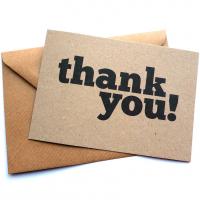How (and How Not) to Say Thank You at Work

I suppose I shouldn’t be surprised to discover the many websites designed to help people say thank you. Even though parents teach their young kids to say thank you, some people apparently lose that skill as they become adults. Or they lack the time. Or forget. Or need help choosing the right words for the situation. In fact, numerous websites exist to help people select just the right words for personal or professional thank-you notes.
One online service takes thanking a step further: You submit your message, choose stationery from a set of options, select your favorite handwriting style, and supply the name and address of the recipient and when the note should be sent. Voilà—a thank-you note is sent on your behalf. Why take the time to write your own note when someone else will do it for you and give the impression you wrote it yourself? The fact that the company is reportedly bringing in big bucks suggests there’s a real need for this service.
I may be old-fashioned in believing that thank-yous are more honest and personal when sent by the person who’s doing the thanking. On the other hand, automated thanking improves the odds that thanking will take place—and that it will be more personalized than some of the thank-you notes I’ve received.
One example of how not to say thank you: After the successful completion of a major project, the manager sent out a mass email thanking the twelve team members, but didn’t name any of them. The message was sent as a BCC, so the recipients couldn’t see who else received it. Given the team size was twelve, not twelve hundred, might not the manager have taken a few additional moments to contact each participant individually? It would have felt much more personal to receive a message that said, “Betty, thank you for all you did to make this project succeed.” Even just naming the twelve team members in the mass email would have been better than the to-whom-it-may-concern email that was sent.
Whether in person or in written form, thanking needn’t be difficult. Keep it simple and be sincere. Make it personal by including details about the thing you’re offering thanks for. Express the thanks in a timely manner—sooner is almost always better than later—and don’t delegate; do it yourself.
Amusingly, when I did a search for “thanking made easy,” the result included links to sites on “thinking made easy.” I hope this article will make it easier for you to think about thanking.

